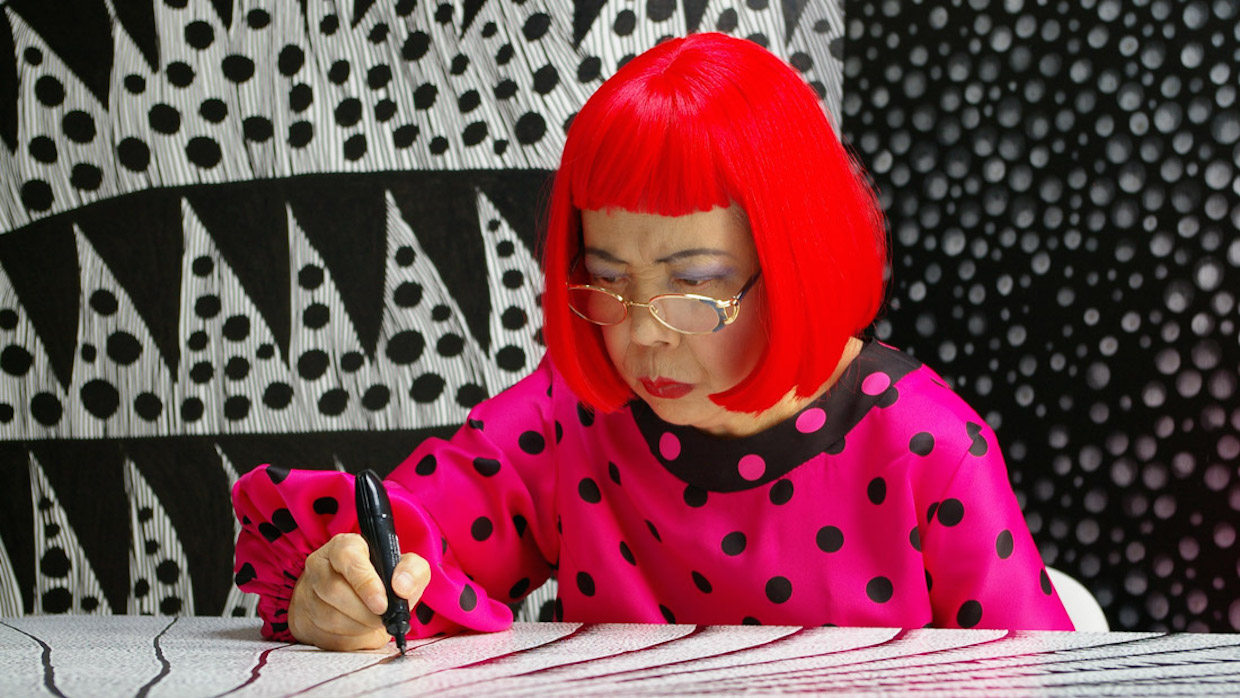
A luminary in the cultural sphere, Yayoi Kusama is considered one of the most critically acclaimed artists of our time. Well known for her hallucinogenic works of dots, nets, pumpkins and infinity rooms, her art has captivated millions all over the world.
To coincide with Heather Lenz’s new biopic, Kusama: Infinity opening at VIFF Vancity Theatre this Friday, May 18, we take a closer look at the extraordinary life and career of the woman behind the dots.
1. Painting became an act of rebellion for Kusama when she was just a child
Born in 1929 in Matsumoto, Japan, she reacted against her parents’ ‘old customs and morals’. Her mother told her she was not allowed to paint and took her inks and canvases away. She left home in her mid-twenties and decided to seek freedom and fame in New York.

2. Georgia O’Keeffe was her business advisor
The famous flower-painting, female artist was business savvy and successful in the 1950s, and Kusama began writing to while in her 20’s asking for advice about how to succeed in the New York art scene. O’Keeffe even persuaded her own dealer to buy several of Kusama’s works when she was in a period of financial trouble due to being hospitalized from exhaustion.
3. Pumpkins were a major part of Yayoi Kusama’s diet during World War II
As a child during that tumultuous period, Kusama’s family relied on pumpkins to feed them, having grown fields of pumpkins in their nursery. Representing comfort and security to the artist, their “solid spiritual balance” appeal to her. The 88-year-old has since presented a new technique to her depiction of pumpkins by using mosaic tiles to cover large pumpkin sculptures.

4. She started creating Infinity rooms as early as 1962
Her initial works used just LED lights, an immersive recreation of her hallucinations. Kusama began experimenting with mirrors in Infinity Mirror Room – Phalli’s Field (1965), a small room surrounded by mirrors and filled with polka-dotted phalluses to create the illusion of vastness. Kusama continued with the use of mirrors for her Infinity Rooms. Her 2016 Infinity Room All the Eternal Love I Have for the Pumpkins, was filled with her signature pumpkins.
5. In 1966 she was ejected from the Venice Biennale
At her first Biennale she exhibited her work Narcissus Garden, which consisted of hundreds of mirrored spheres that she began selling for $2 each while wearing a gold kimono – a comment on the commercialisation of art and self-promotion that didn’t sit well with the organisers of the Biennale and she was promptly escorted from the premises.

6. She’s used fashion as a statement way before her Louis Vuitton collaboration
Decades before designer Marc Jacobs tapped into the artist’s aesthetic for Louis Vuitton’s collection in 2012, Kusama had previously used style to broadcast her views.When she launched her own fashion company in the 1960s, clothes featured not dots but holes, strategically placed for the breasts or buttocks. In the 1970s she made ‘orgy’ garments — to be worn by several people at once.
7. She has spent the last 37 years in a mental health hospital
After her business as an art-dealer in Japan folded, Kusama began experiencing severe mental health problems and checked herself into a psychiatric asylum in Tokyo where she has lived since 1977. From there, she has continued to create art, publish novels and write poetry, while maintaining a studio near the hospital for her large-scale installations.
“I don’t want to cure my mental problems, rather I want to utilize them as a generating force for my art.”
Kusama: Infinity opens this Friday, May 18 at Vancity Theatre. Dress the part and wear your best polka-dotted or Kusama inspired outfit to see the film!
Buy tickets
